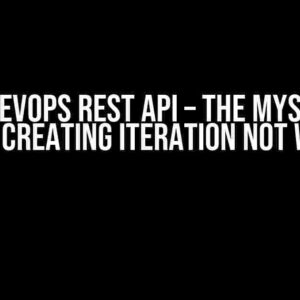In the world of artificial intelligence and machine learning, Azure OpenAI Code Interpreter is a powerful tool that has revolutionized the way we extract insights from unstructured data. However, one of the most common issues that developers face when using this tool is inconsistent text extraction. If you’re struggling with this problem, you’re not alone! In this article, we’ll delve into the reasons behind this issue and provide a step-by-step guide on how to resolve it.
Understanding the Azure OpenAI Code Interpreter
Before we dive into the issue, it’s essential to understand how the Azure OpenAI Code Interpreter works. This AI-powered tool uses advanced natural language processing (NLP) algorithms to analyze and extract relevant information from unstructured text data. The interpreter can be fine-tuned to perform various tasks, including text classification, sentiment analysis, and entity extraction.
The Issue with Inconsistent Text Extraction
Despite its impressive capabilities, the Azure OpenAI Code Interpreter can sometimes produce inconsistent text extraction results. This means that the tool may extract relevant information from some texts but not others, leading to frustrating inconsistencies in your project. So, what causes this issue?
- Tokenization errors: The Azure OpenAI Code Interpreter relies on tokenization to split text into individual words or tokens. However, tokenization errors can occur when the tool struggles to recognize punctuation marks, special characters, or non-standard language patterns.
- Linguistic complexity: The interpreter can struggle with texts that contain complex linguistic structures, such as nested sentences, idioms, or figurative language.
- Domain-specific terminology: The tool may not be familiar with domain-specific terminology, leading to inconsistent text extraction results.
- Data quality issues: Poor-quality data, including typos, OCR errors, or incomplete texts, can affect the accuracy of text extraction.
Step-by-Step Guide to Resolving Inconsistent Text Extraction
Now that we’ve identified the potential causes of inconsistent text extraction, let’s explore the steps to resolve this issue:
Step 1: Preprocess Your Data
Data preprocessing is crucial to ensure accurate text extraction. Here are some steps to follow:
Remove punctuation marks: Use theremodule in Python to remove punctuation marks from your text data.Handle special characters: Replace special characters with their corresponding Unicode characters or remove them altogether.Tokenize your text: Use thenltklibrary to tokenize your text into individual words or tokens.
import re
import nltk
# Remove punctuation marks
text = re.sub(r'[^\w\s]', '', text)
# Handle special characters
text = text.replace('"', '\"')
# Tokenize your text
tokens = nltk.word_tokenize(text)
Step 2: Fine-Tune the Azure OpenAI Code Interpreter
Fine-tuning the Azure OpenAI Code Interpreter involves adjusting the model’s hyperparameters to improve its performance on your specific dataset. Here’s how:
Update the model configuration: Adjust the model’s configuration to suit your dataset, including the learning rate, batch size, and number of epochs.Use domain-specific terminology: Provide the interpreter with domain-specific terminology to improve its understanding of your dataset.
from azure.ai.openai import OpenAIClient
# Update the model configuration
client = OpenAIClient('your_api_key', 'your_api_secret')
model = client.get_model('code-interpreter')
model.config.max_length = 512
model.config.batch_size = 32
# Use domain-specific terminology
domain_terms = ['terminology1', 'terminology2', ...]
model.domain_terms = domain_terms
Step 3: Implement Data Quality Control
Data quality control is essential to ensure accurate text extraction. Here are some steps to follow:
Check for typos and OCR errors: Use tools likepyspellcheckerorlanguage-tool-pythonto detect and correct typos and OCR errors.Handle incomplete texts: Use techniques like data imputation or text completion to handle incomplete texts.
import pyspellchecker
# Check for typos and OCR errors
spell = pyspellchecker.SpellChecker()
misspelled = spell.unknown(text)
for word in misspelled:
text = text.replace(word, spell.correction(word))
Step 4: Monitor and Evaluate the Model’s Performance
Monitoring and evaluating the model’s performance is crucial to identify any inconsistencies in text extraction. Here are some steps to follow:
Track model metrics: Track metrics like precision, recall, and F1-score to evaluate the model’s performance.Analyze model errors: Analyze the model’s errors to identify patterns or trends that can help improve its performance.
| Metric | Description |
|---|---|
| Precision | The ratio of true positives to the sum of true positives and false positives. |
| Recall | The ratio of true positives to the sum of true positives and false negatives. |
| F1-score | The harmonic mean of precision and recall. |
Conclusion
Inconsistent text extraction using the Azure OpenAI Code Interpreter can be frustrating, but it’s not insurmountable. By understanding the causes of this issue, preprocessing your data, fine-tuning the model, implementing data quality control, and monitoring the model’s performance, you can resolve this issue and extract accurate insights from your unstructured data. Remember, the key to success lies in attention to detail and a willingness to experiment and adapt.
So, what are you waiting for? Get started with resolving inconsistent text extraction using the Azure OpenAI Code Interpreter today!
Frequently Asked Question
Get the scoop on the most pressing issues with inconsistent text extraction using Azure OpenAI Code Interpreter. We’ve got the answers to your burning questions!
What causes inconsistent text extraction using Azure OpenAI Code Interpreter?
Inconsistent text extraction can occur due to various reasons such as incomplete or inaccurate training data, inadequate model fine-tuning, or incorrect configuration of the Azure OpenAI Code Interpreter.
How can I troubleshoot issues with inconsistent text extraction?
To troubleshoot issues, review your training data for accuracy and completeness, check the model fine-tuning process, and verify the configuration of the Azure OpenAI Code Interpreter. You can also test the model with different inputs to identify patterns or biases that may be causing the inconsistencies.
Can I use pre-trained models to improve text extraction consistency?
Yes, pre-trained models can significantly improve text extraction consistency. These models have been trained on vast amounts of data and can provide a solid foundation for your text extraction tasks. You can fine-tune these models on your specific dataset to adapt to your requirements.
How do I handle noisy or unstructured data when using Azure OpenAI Code Interpreter?
To handle noisy or unstructured data, apply pre-processing techniques such as data cleaning, normalization, and feature engineering. You can also use data augmentation techniques to generate additional training data that can help the model generalize better to diverse input types.
What are some best practices for maintaining consistency in text extraction using Azure OpenAI Code Interpreter?
Maintain consistency by using high-quality training data, regularly updating and fine-tuning your models, and monitoring model performance. Additionally, implement version control, track changes, and maintain detailed documentation of your models and datasets.



